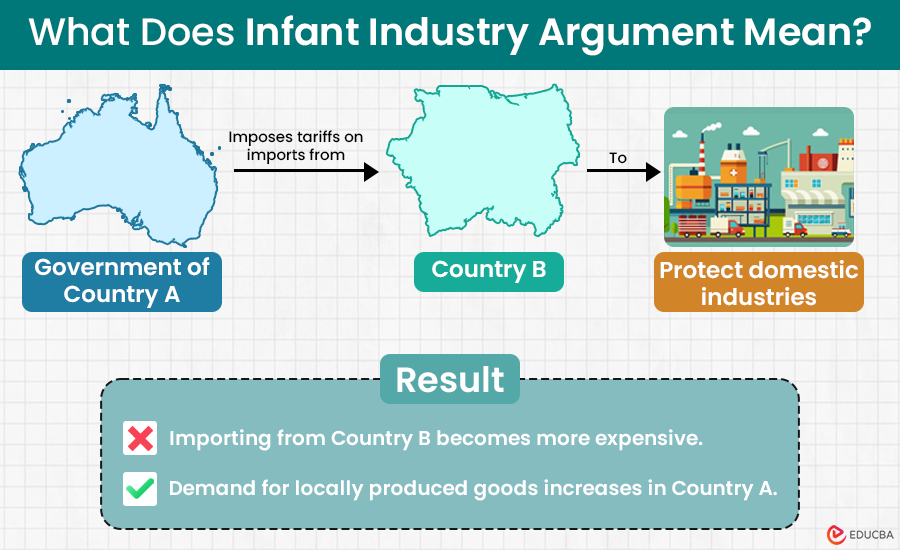
Infant Industry Argument Meaning
The infant industry argument in economics says that a nation must protect its new and developing domestic industries from established foreign competitors to help them grow and become competitive. Without this protection, these young industries might struggle to grow because they face tough competition from more established companies. It is a key idea in international trade and economic policy.
Governments can offer this protection in various ways, such as:
- Tariffs (taxes on imports)
- Quotas (limits on the amount of imports)
- Subsidies (financial help).
By using these methods, governments give these young industries the time and space they need to grow, lower their costs, and eventually compete on an equal level with global players.
This argument helps us understand why some countries adopt policies that protect their local industries from foreign competition.
Why Do New Industries Need Protection?
New industries face several challenges than established industries, like:
- New industries cannot produce goods as cheaply as established industries.
- They lack the experience and expertise that older industries have.
- They need time to generate surplus which they can invest in better production technologies and infrastructure.
How Does the Infant Industry Argument Work?
When a country starts to industrialize, its new industries are at a disadvantage compared to established foreign competitors. They lack the economies of scale and experience that allow older firms to produce more cheaply.
The infant industry argument says the government needs to protect these new industries until they grow and become competitive.
This approach is often controversial because it can seem unfair to existing businesses and consumers, who have to pay higher prices for goods produced by protected industries. However, proponents argue it is necessary to give domestic industry a chance to develop.
Many infant industries eventually become competitive, and as they gain experience, they become more efficient and can lower their costs. However, some industries may need protection indefinitely to survive.
Infant Industry Argument Example
Consider two countries: Country A with a new medtech industry and Country B with an established one. If free trade takes place between two countries, Country B’s industry could dominate, making it hard for Country A’s industry to survive.
To prevent this, Country A imposes tariffs on imported MRI machines, giving its domestic sector a chance to grow and develop competitive advantages.
Let’s understand this in a stepwise manner:
#1. Initial Cost of MRI Machines in Both Countries
#2. Government Intervenes to Protect Domestic Industry
The government of Country A decides to protect its new medtech industry and impose a tariff on imported MRI machines from Country B.
#3. Price of MRI Machines After Tariff
- After imposing the tariff, the price of Country B‘s MRI machines in Country A is $450,000.
- Country A‘s MRI machines, which are still at $500,000, become more competitive.
#4. Impact on Consumer Behavior
- Consumers in Country A now face higher prices for MRI machines.
- They must choose between the imported MRI machines at $450,000 or domestic ones at $500,000.
#5. Country A’s Industry Development Over the Years
- Over time, Country A’s medtech industry grows and achieves economies of scale.
- As a result, its production costs decrease.
#6. Country A’s Medtech Industry Becomes Competitive at the Global Level
- By year 5, Country A’s medtech industry produces MRI machines at the same cost as Country B.
- Thus, Country A’s industry is now competitive.
Criticism of the Infant Industry Argument
Critics of the Infant Industry Argument argue that many successful businesses have grown without government protection, so they don’t see it as a strong reason for government intervention.
Critics also argue that industries should succeed or fail based on free market forces, not government actions. They mention cases where industries have done well without protection, showing that market forces can drive growth and competition. They warn that special interest groups can use protectionist policies to benefit certain industries unfairly. It can lead to inefficiencies and favoritism, known as crony capitalism.
Pros and Cons
| Pros | Cons |
| It protects new industries during their early stages when they are most vulnerable. | Identifying which industries are in their infancy and which are not can be challenging. |
| It encourages firms to improve their products and be innovative. | Infant industries can become competitive only if the governments protect them for a short time. |
| It can create jobs and other economic opportunities in developing countries. | It does not consider the negative impacts on other industries or consumers. |
Final Thoughts
Governments should balance protecting new industries and ensuring fair competition. They should set clear deadlines and slowly reduce tariffs and subsidies to prevent long-term dependency. Governments must also consider how these protections affect consumers and find ways to lower any extra costs they might face.
Frequently Asked Questions (FAQs)
Q1. Who came up with the infant industry argument?
Answer: Alexander Hamilton first introduced the infant industry argument in the late 18th century.
Q2. How does the infant industry argument justify protectionism?
Answer: The infant industry argument justifies protectionism by arguing that new businesses must have time to grow and develop before competing with established businesses from other countries.
Q3. Is the infant industry argument good?
Answer: Opinions vary; it can help new industries grow but also has potential downsides like inefficiency. Some economists support the infant industry argument because they believe new businesses must have time to grow and develop before competing with established businesses from other countries. There are criticisms that say it can lead to crony capitalism, inefficiency, and stagnation.
Recommended Articles
We hope this article on the infant industry argument was helpful. Check these links for similar articles.





